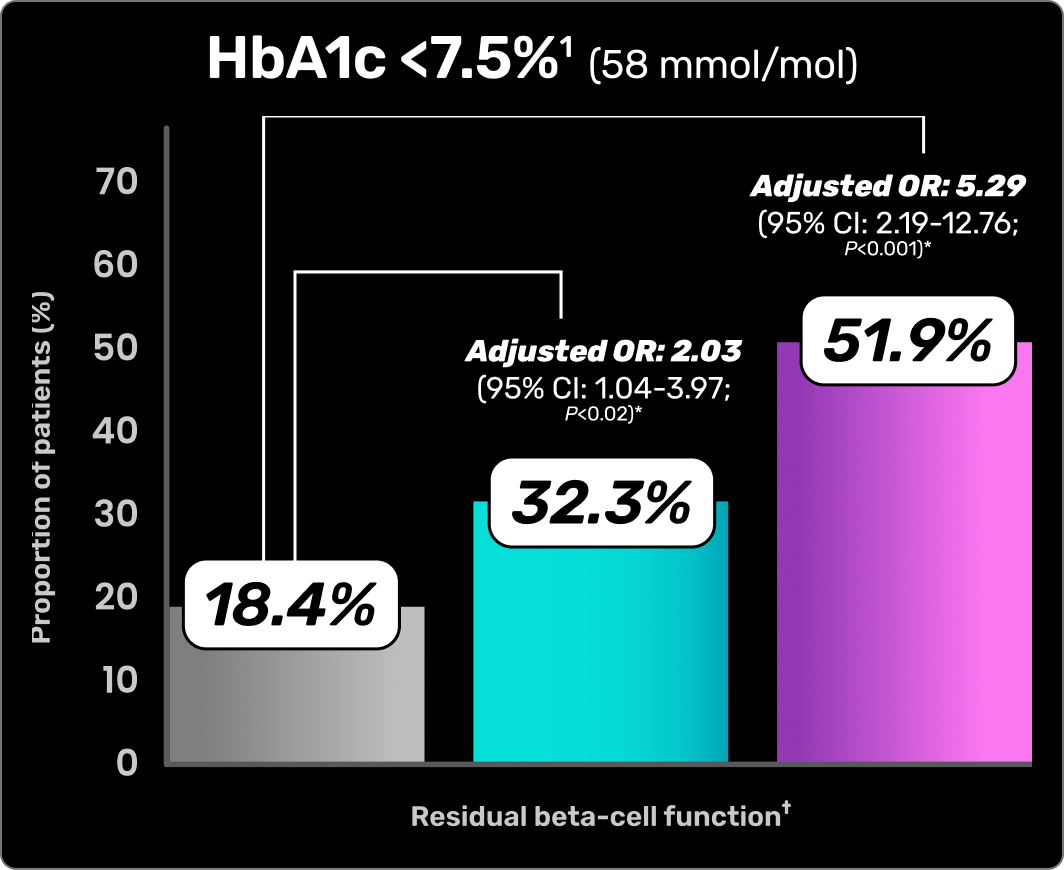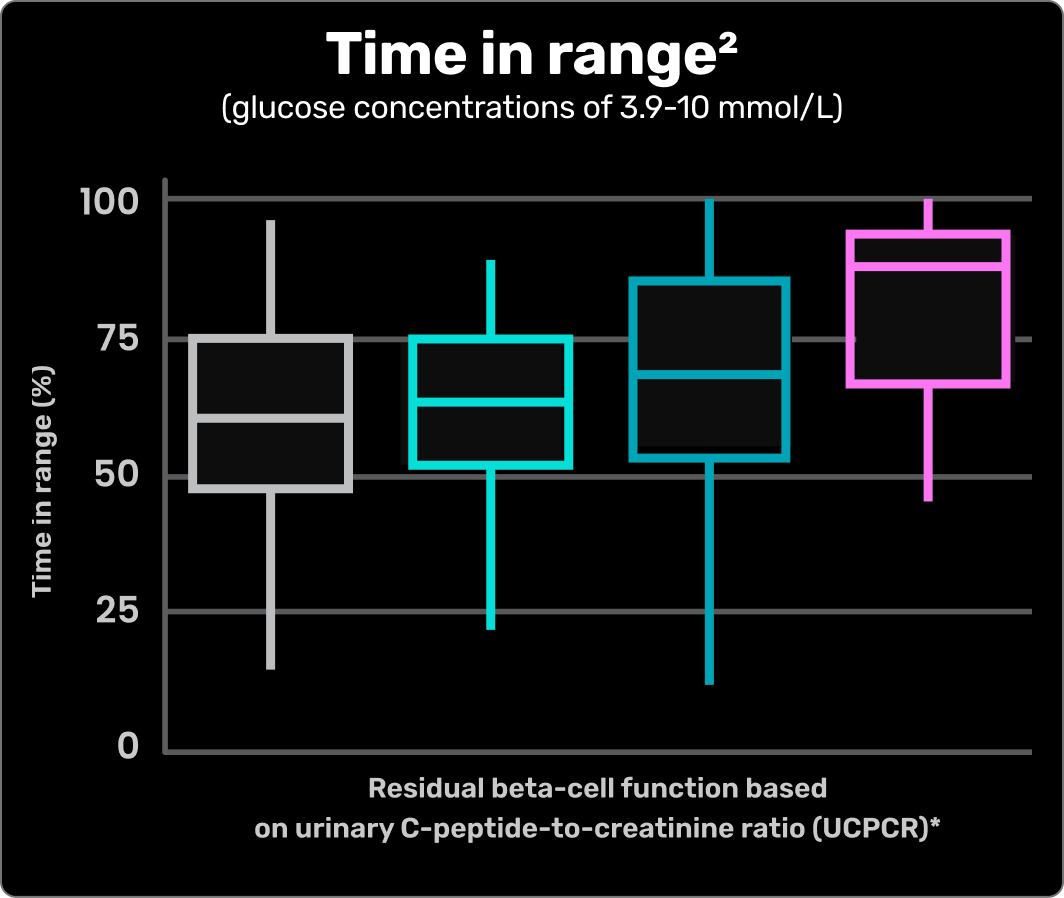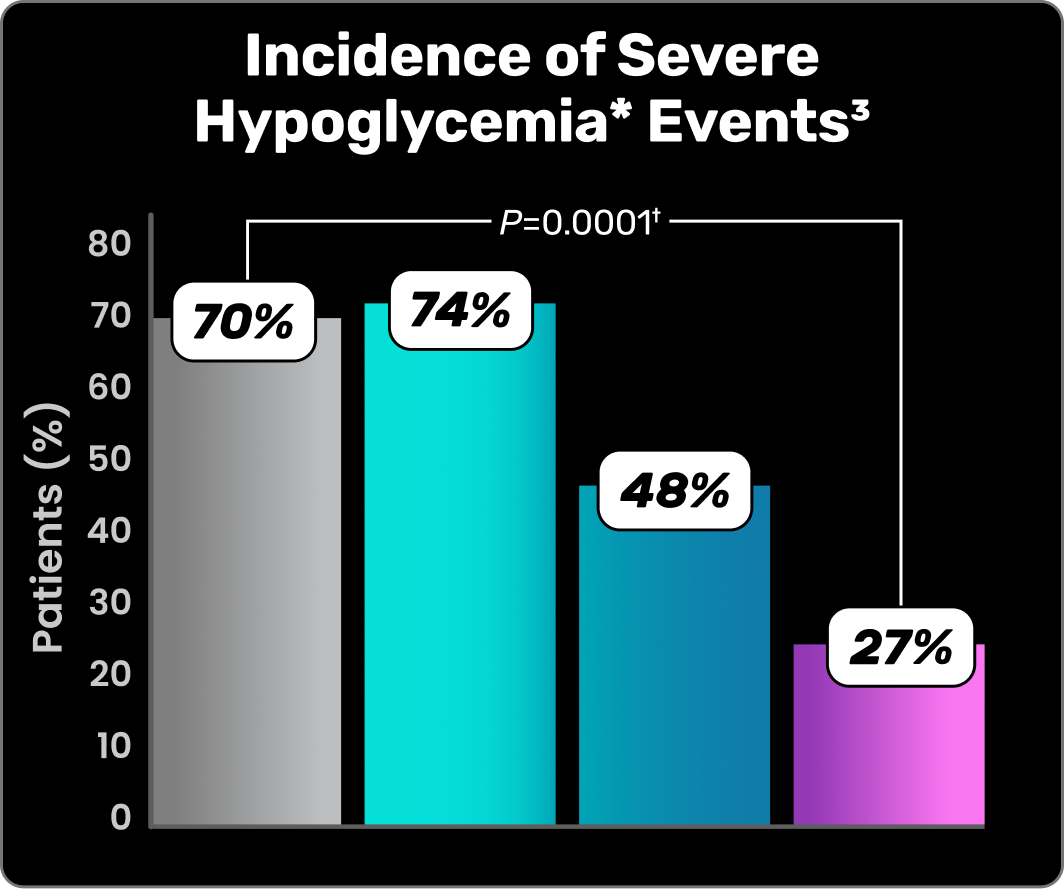
BETA IMPACTS OUTCOMES
FUNCTIONAL BETA CELLS CAN IMPACT CLINICAL OUTCOMES1-9
ROLE IN GLYCEMIC CONTROL

Legend
| None (N=250) <0.04 pmol/mL (0.1 ng/mL) |
Low (N=65) 0.04-0.2 pmol/mL (0.1-0.6 ng/mL) |
High (N=27) >0.2 pmol/mL (0.6 ng/mL) |
RESIDUAL BETA-CELL FUNCTION IS ASSOCIATED WITH LOWER HbA1c LEVELS1
Study overview and limitations: results from Danish Study Group for Childhood Diabetes (DanDiabKids) evaluating 342 pediatric patients aged 4.8-18.9 years with T1D for 3 to 6 years. Limitations were reported for this study. Thirty-nine percent of children eligible for the study according to the DanDiabKids registry did not participate. The HbA1c used for the study was analyzed locally.1
*Logistic regression analysis adjusted for sex, age, pubertal status, diabetes duration, and insulin administration technique.1
†Standard meal–stimulated C-peptide was used to assess residual beta cell function.1
Figure adapted from Sørensen JS, et al. Diabetes Care. 2013.
CI=confidence interval; HbA1c=hemoglobin A1c; OR=odds ratio.

Legend
| Undetectable UCPCR |
Low UCPCR |
Intermediate UCPCR |
High UCPCR |
| (<10 pmol/mmol) |
(10–200 pmol/mmol) | (200–600 pmol/mmol) |
(>600 pmol/mmol) |
RESIDUAL BETA-CELL FUNCTION IS ASSOCIATED WITH LONGER TIME IN RANGE2
Study overview and limitations: results of a cross-sectional cohort study examining the association between residual beta-cell function and glucose control (as metrics of continuous glucose monitoring) in patients with T1D (N=499). Limitations were reported for this study. First, because of the cross-sectional design, it is impossible to make claims of causality. Second, the UCPCR is not considered as gold standard for measuring beta-cell function. Therefore, this study may underestimate the contribution of beta-cell function to CGM-derived metrics and HbA1c. Finally, in the Netherlands, individuals with inadequate glycemic control generally have access to more devices. It is seen that participants with less beta-cell function more often use pumps, but did not obtain a better TIR, suggesting that the association between TIR and UCPCR may be further underestimated in this cohort of individuals with access to advanced tools of diabetes management.2
*Estimated using postmeal urinary C-peptide–to–creatinine ratio (UCPCR): undetectable (<0.01 nmol/mmol), low (0.01-0.2 nmol/mmol), intermediate (0.2-0.6 nmol/mmol), or high (>0.6 nmol/mmol).2
Figure adapted from Fuhri Snethlage CM, et al. Diabetes Care. 2024

C-peptide response to MMTT
| None (N=827) |
Low (N=46) |
Intermediate (N=60) |
High (N=11) |
Stimulated C-peptide (nmol/L)‡
| <0.003§ | ≥0.003 to ≤0.03|| |
>0.03
to ≤0.2|| |
>0.2|| |
RESIDUAL BETA-CELL FUNCTION HAS BEEN ASSOCIATED WITH REDUCED INCIDENCES OF SEVERE HYPOGLYCEMIA EVENTS3-8
Data from the DCCT/EDIC studies
Figure adapted from Gubitosi-Klug RA, et al. J Clin Invest. 2021.3
*Hypoglycemia requiring assistance.3
†Based on Cochran–Armitage trend test.3
‡1 nmol/L C-peptide=3.0203 ng/mL.
§During a 4-hour MMTT, all C-peptide values were <0.003 nmol/L, which was the lower limit of detection for the C-peptide assay used in the study.3
||Peak C-peptide during 4-hour MMTT.3
¶During the DCCT study, patients were asked to report all episodes of suspected severe hypoglycemia immediately, and all subjects were interviewed regarding the episodes using a standard series of questions. During the EDIC study, the ascertainment of events was restricted to the 3-month window prior to the annual visit and used the same standardized questions.3
DCCT=Diabetes Control and Complications Trial; EDIC=Epidemiology of Diabetes Interventions and Complications.
Study overview and limitations: an analysis conducted within the DCCT-EDIC cohort that evaluated residual beta-cell function in individuals with a median T1D duration of 35 years. Beta-cell function was assessed through C-peptide concentrations, measured at 9 time points during a 4-hour MMTT. Participants were categorized by peak C-peptide concentration (nonresponder, low, intermediate, or high), and associations with metabolic outcomes, severe hypoglycemia, and microvascular complications were examined. No limitations were reported for this study.3
IMPACT ON OUTCOMES
Reduced risk of retinopathy and nephropathy are associated with residual beta-cell function.5,8-10

risk reduction of retinopathy observed
in patients with higher C-peptide levels9
(OR 0.55 [95% CI 0.34-0.89], P=0.014)

risk reduction of nephropathy observed
in patients with higher C-peptide levels9
(OR 0.61 [95% CI 0.38-0.96], P=0.033)
Higher C-peptide levels, indicative of higher residual beta-cell function, were observed with lower risk of microvascular complications5,9,10
Study overview and limitations: results of a Finnish study combining longitudinal follow-up data on newly diagnosed individuals with T1D and cross-sectional long-duration data to investigate residual insulin secretion in patients with T1D and evaluate C-peptide levels over time and their link to complications (N=5586). This study has several limitations, including gaps in data due to its retrospective, longitudinal design and small sample sizes in the longitudinal cohorts. The C-peptide assay changed over time, and measurements were taken under nonstandardized conditions. The analysis may be subject to unmeasured and residual confounding, as well as potential selection bias in hazard ratio estimates.9
T1D=type 1 diabetes.
EXPLORING THE BENEFITS AND FEASIBILITY OF...
A range of investigational mechanisms are currently being studied including, but not limited to:
DOWNREGULATION AND DISRUPTION OF T1D AUTOIMMUNE MECHANISMS11
IMPROVING INSULIN SENSITIVITY13
REGENERATION AND REPLACEMENT OF FUNCTIONAL BETA CELLS11
References
- Sørensen JS, Johannesen J, Pociot F, et al. Residual β-cell function 3-6 years after onset of type 1 diabetes reduces risk of severe hypoglycemia in children and adolescents. Diabetes Care. 2013;36(11):3454-3459.
- Fuhri Snethlage CM, McDonald TJ, Oram RD, et al. Residual β-cell function is associated with longer time in range in individuals with type 1 diabetes. Diabetes Care. 2024;47(7):1114-1121.
- Gubitosi-Klug RA, Braffett BH, Hitt S, et al. Residual β cell function in long-term type 1 diabetes associates with reduced incidence of hypoglycemia. J Clin Invest. 2021;131(3):e143011.
- Jeyam A, Colhoun H, McGurnaghan S, et al. Clinical impact of residual C-peptide secretion in type 1 diabetes on glycemia and microvascular complications. Diabetes Care. 2021;44(2):390-398.
- Palmer JP, Fleming GA, Greenbaum CJ, et al. C-peptide is the appropriate outcome measure for type 1 diabetes clinical trials to preserve beta-cell function: report of an ADA workshop, 21-22 October 2001. Diabetes. 2004;53(1):250-264.
- Lachin JM, McGee P, Palmer JP; DCCT/EDIC Research Group. Impact of C-peptide preservation on metabolic and clinical outcomes in the Diabetes Control and Complications Trial. Diabetes. 2014;63(2):739-748.
- Steffes MW, Sibley S, Jackson M, Thomas W. β-cell function and the development of diabetes-related complications in the diabetes control and complications trial. Diabetes Care. 2003;26(3):832-836.
- Nathan DM. Realising the long-term promise of insulin therapy: the DCCT/EDIC study. Diabetologia. 2021;64(5):1049-1058.
- Harsunen M, Haukka J, Harjutsalo V, et al. Residual insulin secretion in individuals with type 1 diabetes in Finland: longitudinal and cross-sectional analyses. Lancet Diabetes Endocrinol. 2023;11(7):465-473.
- Leighton E, Sainsbury CAR, Jones GC. A practical review of C-peptide testing in diabetes. Diabetes Ther. 2017;8(3):475-487.
- Pociot F. Capturing residual beta cell function in type 1 diabetes. Diabetologia. 2019;62(1):28-32.
- Von Scholten BJ, Kreiner FF, Gough SCL, von Herrath M. Current and future therapies for type 1 diabetes. Diabetologia. 2021;64(5):1037-1048.
- Nowak C, Lind M, Sumnik Z, et al. Intralymphatic GAD-Alum (Diamyd®) improves glycemic control in type 1 diabetes with HLA DR3-DQ2. J Clin Endocrinol Metab. 2022;107(9):2644-2651.
- National Cancer Institute. Definition of allogeneic human stem cell-derived pancreatic islet cells VX-880. Accessed February 12, 2025.
- Pathak V, Pathak NM, O'Neill CL, Guduric-Fuchs J, Medina RJ. Therapies for type 1 diabetes: current scenario and future perspectives. Clin Med Insights Endocrinol Diabetes. 2019;12:1179551419844521.
MAT-US-2504445-v1.0-05/2025
